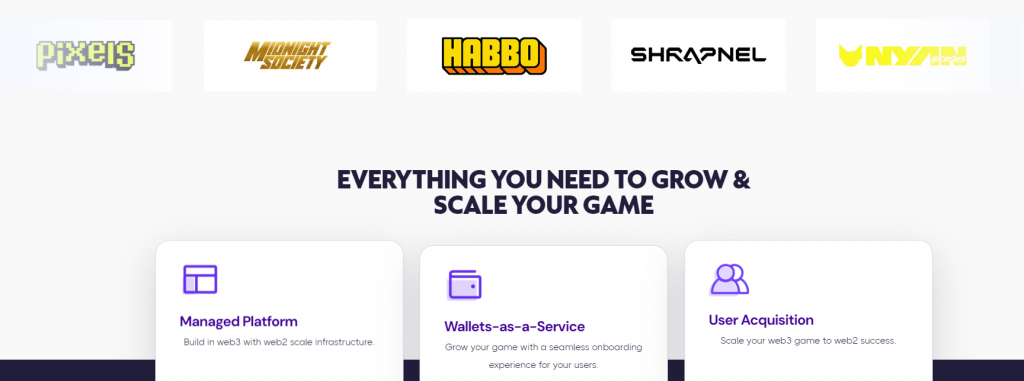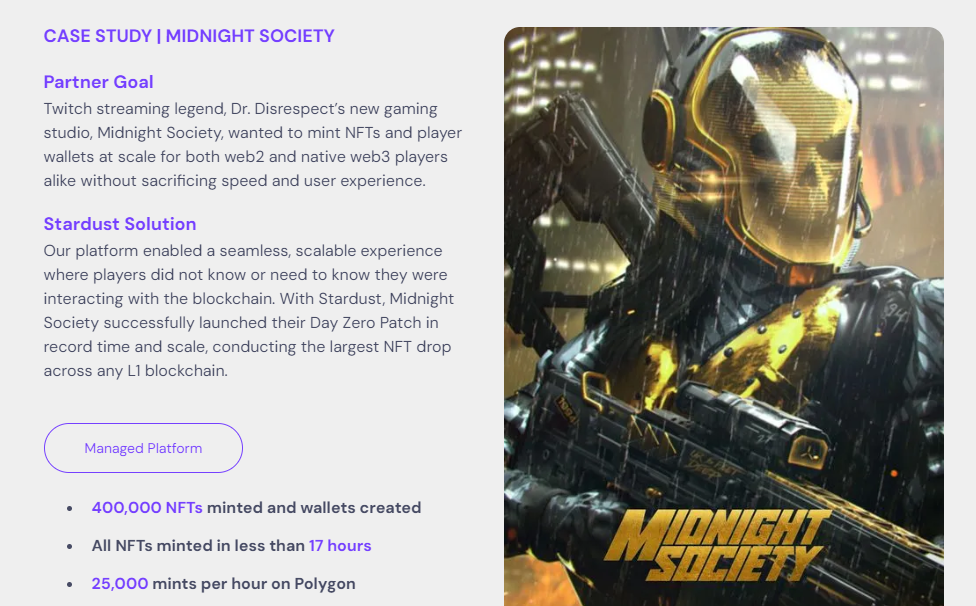How Stardust is helping blockchain devs onboard one billion gamers

In the latest episode of his Blockchain Gaming World podcast, editor-in-chief Jon Jordan talks to Stardust CEO Canaan Linder about his entry into blockchain gaming, how Stardust is helping developers build and scale their games and why he thinks billion blockchain gamers is inevitable.
This interview has been edited for length and clarity.
You can also listen to the podcast via the Fountain app and earn Bitcoin.
BlockchainGamer: So how did you get into the industry?
Canaan Linder: I’m based in and grew up in Palo Alto, California. Before that I was a software engineer in New York City at Bloomberg. Really enjoyed it. But like everybody in crypto, I came across CryptoKitties in 2017. And I said, ‘These are incredible digital collectibles, true ownership. We need these in games’. As an engineer, I tried to build a little game with them and realized it’s a really difficult experience.
Fast forward to today, six years later, Stardust helps some of the largest games in web3 scale to millions of players – Shrapnel, Midnight Society, some web2 properties like Habbo. That’s our mission, to make sure every game developer who leverages this new technology has everything they need to make them successful in this new era of gaming.
It’s interesting how CryptoKitties sparked the interest of so many people in blockchain gaming. Why do you think that was the case?
It’s actually interesting because it’s why we’re named Stardust. I was a competitive Yu-Gi-Oh! player in high school and my favorite card was the Stardust Dragon. I was a collectible card enthusiast and collector for quite a few years and still am to this day. I understood the background of physical ownership, but CryptoKitties opened my eyes to the concept of digital ownership, which is not something … you know, I don’t wake up in the middle of the night worrying that I don’t own my digital collectibles in Fortnite.
But this concept of having the digital ownership of this silly cat that I could take around the internet, that was connected to me, that eventually I could verifiably post that I owned on Twitter, these were the things that I was like, ‘My gosh, I can get Ninja to sign my Fortnite skin’. So our company was built around this concept of true ownership and came from my love of collectible cards. I wanted to give everybody else this ability too through the games they were playing on blockchain.
So how come you didn’t end up making games and made tools instead?
I’m very attuned to where our core competencies are. There are great game developers who’ve been making some of the greatest games. I love creating, building, seeing games, but I’m not the best creator. But we can give the tools to the biggest and best creators to build the best games they can build. And so that’s what we’ve been on a mission to do since six years ago.
What sort of trends have you seen in the sector?
For want of a better term gaming is a very copypasta industry. Something works and then they stamp it out 15 times. You got your Flappy Bird tappers, right? You got your left, right swipers like Fruit Ninja. There are these concepts of human behavior that games take advantage of, not in a bad way, but to give experiences and enjoyment over and over and over.
In blockchain, when it’s a bull market, everybody wants to take what’s working, Axie Infinity, Pixels, whatever it is, and they come and they say, ‘Give me this as fast as possible. Don’t care what chain it’s on. Don’t care why it’s on this chain. I want this game, I want the players’. And in a bull market that works well, because everybody’s doing well.
Now, if you go into a bear market, that’s when a little bit more of the experimentation happens. You see game developers starting to say, ‘This chain is better for my technologies, this chain has a better community’. They take time and effort and make a lot of custom choices about where they want to build.
This has really informed our product in a couple of key ways, keeping it extremely modular so the game developers in times of expansion and need something fast can put all those Lego blocks together really quickly versus when it’s a little bit more of a builder’s market through the bear. Then they have the ability to fit into their stack what works best for them.
More specifically, what actually is Stardust?
We have two core products. We have our infrastructure product, which is wallets-as-a-service, so that helps game developers to create millions of wallets for their game. We work with everyone from the biggest games like Shrapnel and Midnight Society, all the way to web2 publishers, such as Tilting Point and Stillfront. This allows game developers to scale with the technology they need.

Through building this we realized that scaling in gaming is not easy. Whether it’s web3 or web2, user acquisition is really difficult. So the other product we have is Stardust UA. That’s actually a programmatic DSP that allows game developers to bring millions of players to their game.
It’s a very web2 product but applied with web3 technology and web3 data. We know a lot more about who are the correct players to bring to your game, especially in web 3 because there is so much blockchain data we can use to really understand who the best players are in your game and how to bring them into your ecosystem. So between infrastructure and UA, we support game developers with the ability on the infra side to support millions of players, with the ability on the UA side to acquire millions of players.
Can you explain wallet-as-a-service in more detail?
It’s a bit similar to Stripe. I’ll use that as an example. When you open your phone and your DoorDash account, you don’t set up a bank account, but in the backend, you have a whole economic system that DoorDash has not built themselves. They’re leveraging Stripe. The way to send payments from yourself to the restaurant, the way for the restaurant to hold money, for them to get it into their bank accounts. All of the liability is in the backend and that plumbing is done by Stripe so DoorDash focuses on creating a consumer app. That’s true about Shopify. That’s true about Uber. They’re all using the plumbing that Stripe has created.
On the wallet side, there’s security and there’s legal and regulatory risk. These are things that game developers don’t want to focus on. They just want to build great games. When my grandmother plays Candy Crush, she opens her phone and she plays Candy Crush. She does not set up a Metamask wallet.
With wallets-as-a-service, when someone opens a web3 game, they have no idea what blockchain is but behind the scenes they can have a blockchain wallet set up for them, secured in a compliant manner and they can just play the game as it was intended to be played. For games, this is exactly what we do. We allow players to have that incredible in -game experience. We allow game developers to have that incredible experience of building games without worrying about backend infrastructure. That’s where Stardust fits in to complement the whole gaming industry and the next billion players on web3.
How much of that legal and regulatory risk do you want to solve yourselves or do you plug into other providers?
There are two verticals of licensing, especially in the US and even worldwide, that are extremely important. In the US we have businesses that register as a money services business and that just means they deal with money and other people’s money. And then we have money transmitters and this means that you are regulated to hold and transmit money on others’ behalf. So if you look at Coinbase, if you look at Stripe, if you look at any bank, they have this huge framework of money transmitter licenses
These are not easy to get. We’re on our path. We’ve acquired well over half of the needed prerequisites to get money transmitter licenses in all 50 states. I believe we’re at about 27 today and we’re tracking very well to be at 50 sooner rather than later. We’ve been doing this for two and a half years.
Recently the FBI has shut down multiple wallet providers. You see different service providers trying to get around this through things like key delegation and MPC (Multi-Party Computation) and it doesn’t work. You need the regulatory backing to hold money and transmit it on behalf of others, not only for the SEC but for FinCEN and the FTC as well because the Federal Trade Commission really does care. We’re also starting to see this proliferate globally with laws like VASP in Korea and MiCA in Europe.
It’s interesting that you feel it’s core to your business to get all these licenses.
I will clarify that we’re not trying to build everything internally. We are going to use other service providers, the Stripes and Personas of the world. But we want to take the highest leverage point, which is those money transmitter licenses and make sure we own them
Moving to UA, what’s the hardest thing about scaling it?
When you look generally at ad networks, our one goal is to have a billion players playing games. The billion player mark or the billion user mark is really how these ecosystems have enough quality of data to become more valuable. Facebook is the perfect example, their first KPI was a billion people leveraging Facebook. That’s really our focus. You hear it again and again – a billion players playing blockchain-based games. That’s a vision we buy into.
In addition, blockchain data is incredibly valuable from the perspective of knowing what the expected values of users are and how much money they have to actually spend in-game when you’re bidding.

Currently when you’re trying to acquire users for a web2 game, it’s all probabilistic. This person lives in the US, in a nice area code. They must be a whale. They should come play my game. But there’s no real understanding of who that person is. This person is in India. They must want to play my hypercasual game because they don’t buy a lot of things in-game, they typically watch ads. You get these generalities. Blockchain lifts the lid, providing an understanding of who this person is and gives us back some of the granularity that Apple took away from the ecosystem.
We’re early on in that path but the data that exists on blockchain is so much more granular, so much better. We believe that the identifier that people will be tagged with is a wallet address, whether they know it or not, because that is their identity. Whether it’s a wallet through Metamask or a wallet through a service product like ours, we firmly believe that a wallet address is going to be your unique tag as you move around the internet which defines you, so that game developers and other app developers and even stores understand more about who you are.
Does this mean users will get back value for providing their data?
This has been tried before in the web3 space. Brave browser and the Basic Attention Token, it was an early way for people to get compensated for their time and attention on the internet, But for better or worse, it didn’t fully capture the value people thought it would because individuals think their data is worth a lot of money. The unfortunate point is only in aggregates of millions of data points is data worth something tangible. If you’re getting compensated 50 cents for your data or 10 cents for your data, it doesn’t really hit the same way.
I think it will be that the value you get by providing more data about yourself to applications on the internet will be passed down in kind. Something like ‘You connect your Twitter in-game, you get extra XP or a free skin. You connect your wallet address, you may level up five levels and get no ads for the next 30 days.
This matters more to you than pennies on the dollar and that’s really important because people don’t want to feel nor should they feel it’s just arbitrage – give me your data. I give you five cents and I get six. We should be providing players with value for telling the games more about themselves so that the games can give them a better experience within the game and better enjoyment and the games will compensate them justly for that.
You’re talking about one billion web3 gamers, but at the moment we’re struggling to get a couple of millions.
It’s hard for our minds to conceptualize exponential growth. We always think linearly. We think if there’s a million this year, how can there be a billion next year? It can happen. I think we can get there. I can’t ascribe a time period to it but what I will say is we can get there at any point because all it takes is somebody to find a better model.
I love going back to mobile because everything we do in gaming, especially in blockchain today with incentivized engagement, questing platforms, play-to-earn is just app store optimization and incentivized downloads in 2009. It’s the same thing packaged in a different way.

If you look at Facebook, Mafia Wars was number one, and then Zynga came out with FarmVille. Dapper Labs did CryptoKitties and then NBA Top Shot. Now we have Axie Infinity and Pixels on Ronin. We see the exact same trend in blockchain today that we saw in gaming. Close our eyes and wake up, tomorrow there’ll be four more Pixels and a billion players in blockchain. I can’t tell you when but what I can tell you is that as soon as that formula is figured out, everybody’s ready to pour fuel on the fire, right from from your smallest indie developer, all the way up to the Scopely and the EAs of the world. They’re all waiting on the sidelines to see what works.
Do you think the infrastructure problems are solved in terms of currently being able to support games with 50 million DAUWs?
Of course. Blockchain scaling is getting better. If you had said in the days of CryptoKitties, could you imagine a game with 5,000 players, I would have said ‘No way’.
When game developers come to us, we like to have them create games that are the true embodiment of what they think a great game can be, not being constrained by what the technology is today. We’ve seen so many people clip their wings and fit into a box of what the technology allows today rather than understanding that the technological growth curve especially in blockchain is so quick and so fast, faster now than it’s ever been.
I do believe blockchain can support a billion players. In what topology it will be, whether that’s thousands of L2s, whether it’s Sui, Aptos and Solana together, I can’t tell you. I don’t know. I don’t have a crystal ball. But we will get there. It’s not an ‘if’ but ‘when’.
Find out more about Stardust via its website.

Comments are closed.